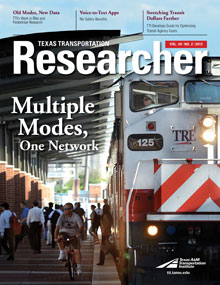
It’s a scene that plays out every day on America’s highways: vehicles stuck in traffic due to overly congested roadways. Has the cost of congestion been accepted as a way of life, or are there other efficient means, such as passenger rail, of getting from Point A to B?
“Certainly passenger rail is not the only solution to congestion, but it might be a part of the answer,” says Texas A&M Transportation Institute (TTI) Assistant Research Scientist Curtis Morgan. Morgan manages TTI’s Multimodal Freight Program, which has recently been involved in several cross-cutting rail research projects in Texas and around the nation. “Widening roadways or expanding existing airports is becoming extremely expensive, so investments in freight and passenger rail need to be looked at as another means of improving the transportation system.”
One recent project involved studying the mobility implications and economic benefits of providing passenger rail service in a short- to medium-distance intercity travel corridor. To accomplish this, the researchers distributed travel surveys to passengers on board the Amtrak Heartland Flyer, a passenger rail service that runs a 206-mile route between Oklahoma City and Fort Worth. The results of the study showed an estimated economic benefit of over $18 million per year in cities along the corridor, a positive cost-benefit ratio given that each state only provides Amtrak with $2.5 million a year to operate the service.

Another project involved the study of a multimodal intercity corridor using Amtrak’s Milwaukee–Chicago Hiawatha service passenger rail route.
“One of the unique features of this corridor is that it’s one of only four places in the United States that Amtrak has a stop at an airport,” says Morgan. “We looked at the impact the service to the airport had and found that one-third of air–rail passengers would have used one of the Chicago airports if the rail service had not provided convenient access to the Milwaukee airport.”
According to the researchers, the distance of the route studied nearly mirrors the distance between Austin and San Antonio, making it a useful case study for the potential of multimodal rail corridors in Texas.
The group also examined longer intercity and interregional corridors within Texas to determine which are most likely to need additional intercity travel capacity in the coming decades. The project looked at current and future population and demographic projections along 18 intercity corridors and projected future demand. A preliminary concept plan was developed during the first year of the project, and the second year focused on determination of potential costs and benefits of implementing the concept plan.
TTI’s recent intercity rail projects have provided state decision makers with the data to make informed decisions about where a rail line might be most effective, the economic benefits of such a rail line, and how a true multimodal corridor could be implemented between two major urban areas.
“The development of intercity passenger rail is about true multimodal solutions to the problem of moving people,” says TTI Assistant Research Scientist Ben Sperry. “As cities grow, demand for travel between cities will also grow to the point where passenger rail investment should be considered. It’s not reasonable to expect everyone to use the train for every trip out of town, but there may be enough demand to make an intercity passenger rail system in Texas a viable mobility solution.”

